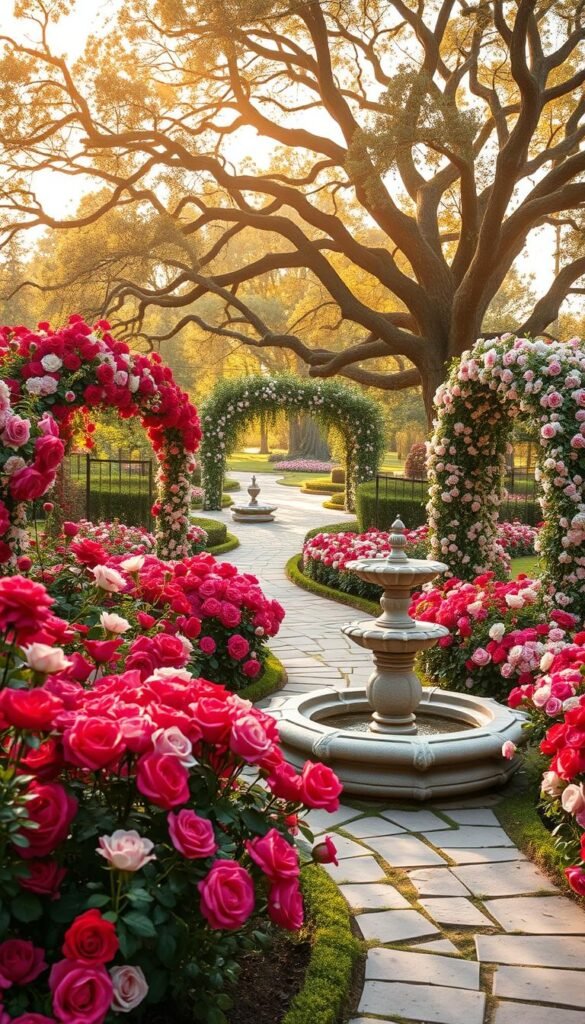Imagine stepping into your backyard and finding a living canvas where fragrance dances with color. Expert designer James Farmer describes these magical areas as places “where memories take root and senses awaken.” His celebrated Farmdale estate demonstrates how structured layouts can harmonize with nature’s spontaneity, offering inspiration for cultivating your own slice of paradise.
Today’s approach to floral landscapes blends heritage charm with smart solutions. Modern varieties bloom longer while requiring less care than older cultivars, letting you enjoy vibrant petals without constant upkeep. You’ll learn how flowering trees and resilient shrubs create year-round interest, adapting traditional cottage aesthetics to contemporary needs.
Your outdoor area should invite both celebration and reflection. Through strategic plant placement and thoughtful hardscaping, you’ll craft environments perfect for hosting gatherings or savoring morning coffee. Discover how textures like stone pathways and wrought iron accents enhance visual storytelling while supporting plant health.
This guide reveals professional techniques for balancing beauty and practicality. From selecting climate-appropriate varieties to establishing efficient care routines, every recommendation focuses on helping your living masterpiece thrive. Let’s explore how to transform ordinary yards into extraordinary retreats that engage the heart and imagination.
Understanding the Romance of a Rose Garden
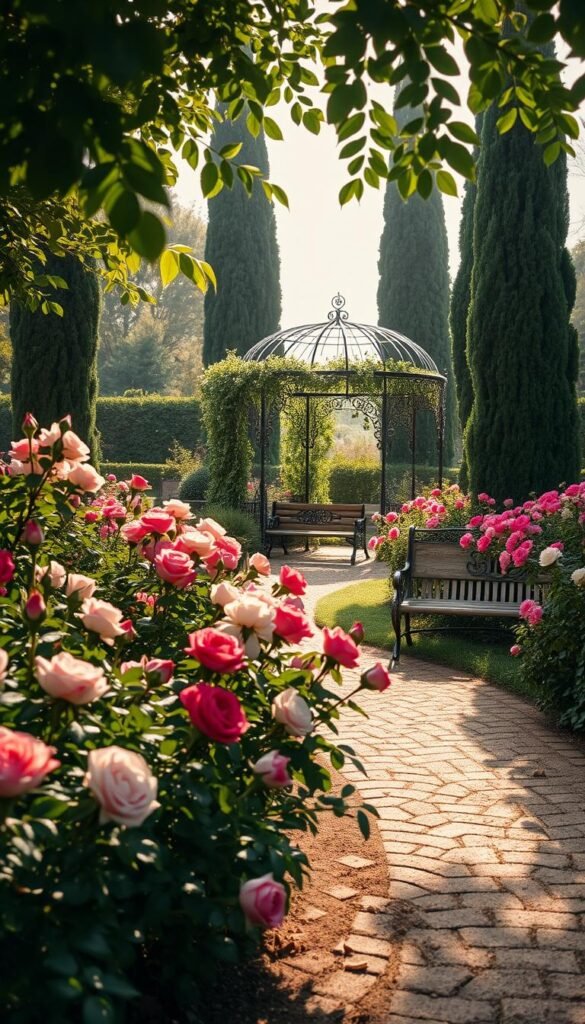
Picture sunlight filtering through climbing vines as petals brush against weathered stone. This balance of wild growth and intentional structure defines romantic outdoor spaces. As designer James Farmer notes, “True magic happens when nature’s chaos meets human care.”
What Makes a Garden Romantic?
Romance thrives in contrasts. Think billowing flowers beside crisp pathways or fragrant blooms framing sleek seating. Modern hybrids let you enjoy lush blossoms without constant upkeep. Linda Knowles transformed her backyard using memories of French rose parks, proving personal stories shape extraordinary spaces.
Infusing Storybook Charm with Modern Style
Today’s best layouts blend nostalgia with practicality. Try these ideas:
- Mix soft pink blooms with gray-green foliage for timeless appeal
- Use curved benches to invite lingering moments
- Pair classic varieties with disease-resistant newcomers
Your space should feel lived-in, not perfect. Wrought iron arches covered in climbers create vertical interest while supporting plant health. Remember: beauty lies in details that spark joy, not rigid symmetry.
Essential Garden Planning for Full Sun and Shade Areas
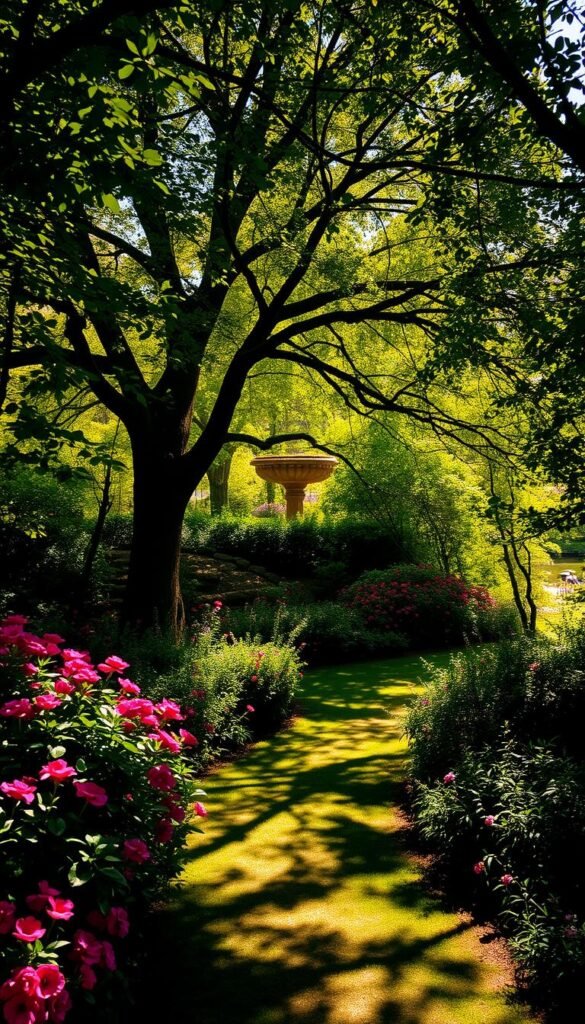
Mapping sunlight patterns transforms guesswork into strategy. Observe how beams travel across your yard at dawn, noon, and dusk. Many flowering favorites need six hours of direct sun daily, but clever placement lets you work with what you’ve got.
Assessing Sunlight and Shade in Your Space
Linda Knowles proves shaded spots can thrive. Her David Austin varieties flourish near structures that filter afternoon rays. Try these tactics:
- Track shadows monthly—tall trees cast differently in June vs October
- Position arbors 6-7 feet apart (like Linda’s setup) for light optimization
- Use evergreen shrubs as James Farmer does to shelter tender blooms
Vertical structures serve dual purposes. Trellises boost climbing types into brighter zones while creating dappled shade below. This layering technique lets you grow sun-lovers and shade-tolerant companion plants side by side.
| Sun Exposure | Rose Types | Companion Plants |
|---|---|---|
| Full Sun (6+ hours) | Hybrid Teas | Lavender, Sage |
| Partial Shade (4-6 hours) | ‘Mutabilis’, ‘Eden’ | Hostas, Ferns |
| Filtered Light | Old Garden Varieties | Hydrangeas, Heuchera |
Leave breathing room between plantings. Proper spacing prevents mildew and lets each specimen shine. Remember—light patterns shift with seasons. What’s shaded in spring might bake in July. Adapt your layout yearly for continuous beauty.
Selecting the Perfect Roses and Complementary Blooms
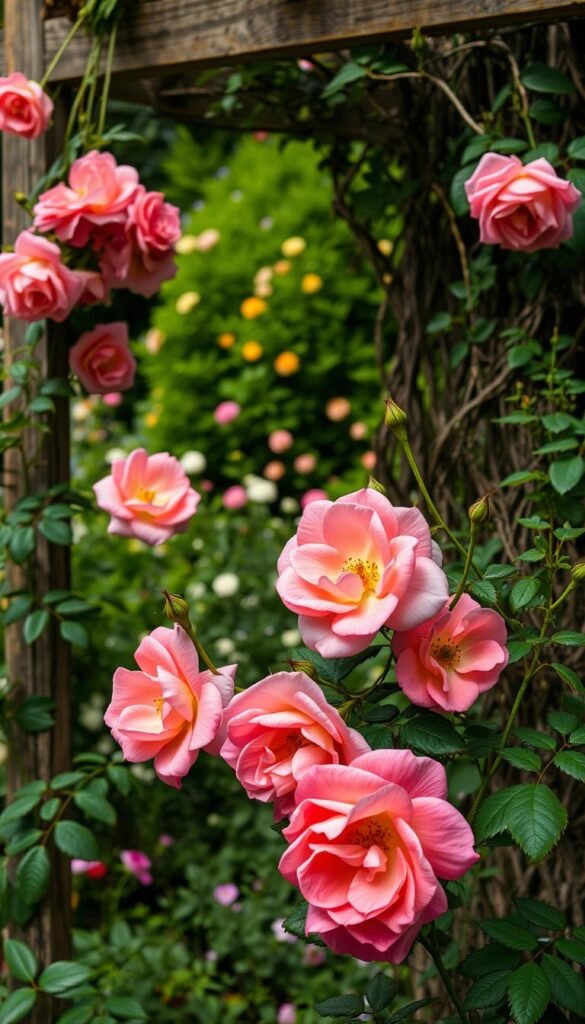
Your floral sanctuary begins with smart plant choices. Expert growers like Linda Knowles – who tends 300 specimens – prove variety selection determines success. Let’s explore how different types create harmony while meeting your lifestyle needs.
Hybrid, Shrub, and Climbing Rose Varieties
Hybrid teas deliver classic elegance with their sculpted buds, perfect for formal arrangements. Linda’s ‘Eden Rose’ demonstrates their lasting power, blooming from spring through frost. For easier care, shrub types like ‘William Baffin’ offer disease resistance and nonstop flowers.
James Farmer’s topiary specimens show how structured forms add architectural interest. Meanwhile, climbers like fragrant ‘Abraham Darby’ transform fences into living tapestries. Pat Leuchtman mixes heritage gallicas with modern David Austin varieties for continuous color.
Try this simple formula:
- Foundation plants: Sturdy shrub roses (3-5 specimens)
- Vertical accents: Climbers on arbors or trellises
- Focal points: Hybrid teas in containers or borders
Pair your selections with lavender or boxwood hedges. These companions highlight petal colors while deterring pests naturally. Remember – the best combinations balance beauty with backyard realities.
Designing Structured Spaces with Parterre and Natural Beds
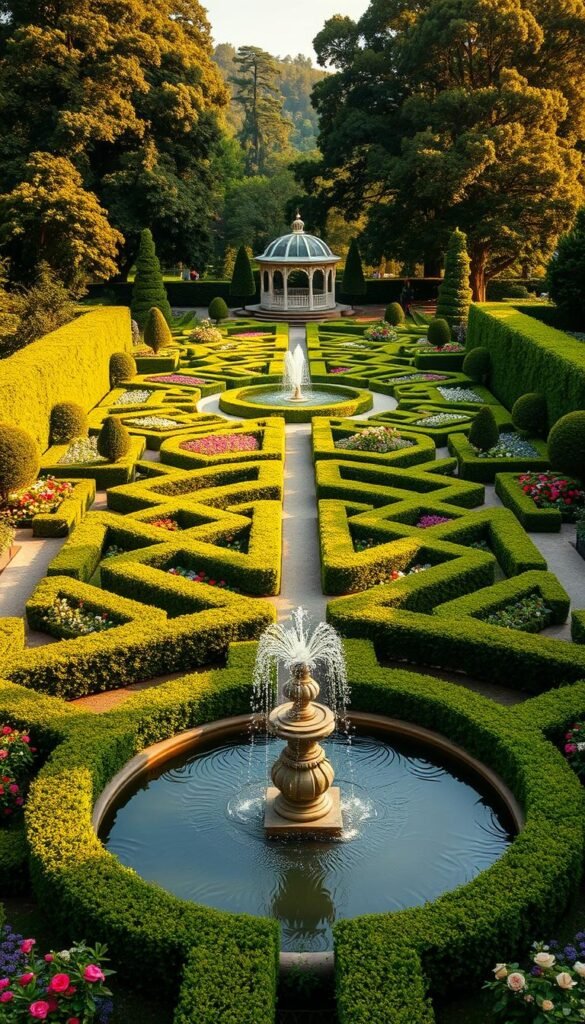
Geometry meets romance when crisp hedges frame billowing blossoms. James Farmer’s walled oasis proves structured layouts needn’t feel stiff – his four symmetrical beds burst with casually arranged florals around a circular centerpiece. This approach lets you guide the eye while celebrating nature’s spontaneity.
Creating Geometric Patterns for Visual Impact
Start with clean lines that anchor your space. Low-maintenance santolina or boxwood work beautifully for edging, as seen in Linda Knowles’ lavender-accented beds. These living borders create crisp shapes that contrast with softer plantings inside. Keep pathways wide enough for easy access – 3 feet works well for most structured layouts.
Blending Formal and Informal Plantings
The magic happens when order meets whimsy. Try tree roses as centerpieces surrounded by loose herbs like thyme or oregano. Farmer’s design uses this contrast brilliantly – precise hedges contain carefree clusters of floribundas and perennials. For modern appeal, mix traditional roses with drought-tolerant companions like catmint or Russian sage.
| Design Element | Material | Purpose |
|---|---|---|
| Bed Edging | Boxwood | Defines geometric shapes |
| Pathways | Gravel/Stone | Creates visual flow |
| Focal Point | Specimen Tree | Anchors the layout |
| Filler Plants | Lavender/Santolina | Softens hard lines |
Remember scale when planning. Center features should command attention without overwhelming – Linda’s lime tree stands 12 feet tall in her 30×40 foot space. Leave 18-24 inches between hedges and flowering plants for healthy growth. This balance ensures every element shines while maintaining that coveted “lived-in elegance”.
Infusing Your Garden with Modern Romantic Inspirations
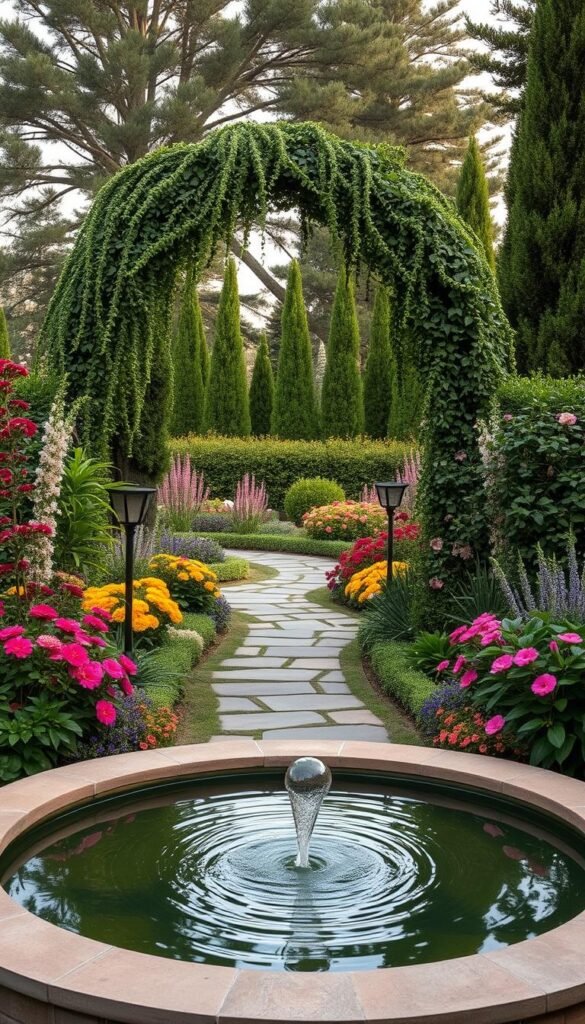
Today’s lush landscapes blend timeless elegance with smart solutions. The 2024 “Garden of Romance” trend thrives through clever plant choices that weather climate shifts while keeping care simple. New cultivars bloom longer while resisting diseases that plagued older varieties, letting you enjoy vibrant colors without constant fuss.
Breeders now craft specimens offering six-month bloom cycles and built-in disease resistance. James Farmer’s signature space demonstrates this perfectly – evergreen shrubs form a leafy framework for florals that peak from spring through frost. Flowering trees like crape myrtles add vertical drama while needing 30% less water than traditional options.
| Feature | Traditional Approach | Modern Solution |
|---|---|---|
| Bloom Duration | 4-6 weeks | 3-6 months |
| Maintenance | Weekly pruning | Self-cleaning varieties |
| Climate Resilience | Limited adaptability | Drought-tolerant roses |
| Aesthetic | Formal arrangements | Structured wildness |
Smart selections pull double duty. Consider varieties like ‘Wedding Bells’ hydrangeas that transition from ivory blooms to burgundy foliage, or fragrant ‘Desert Eve’ shrubs needing minimal pruning. These multitaskers create layered beauty without demanding your weekends.
Sustainability meets splendor in contemporary layouts. Native grasses nestle between flowering specimens, supporting pollinators while reducing water needs. It’s about creating spaces that feel abundant yet intentional – where every element serves both ecology and emotion.
Rose Garden Design Tips: Planning a Romantic, Bloom-Filled Space
Your outdoor sanctuary becomes reality through intentional layering of structure and softness. James Farmer advises “building from the ground up”, starting with drainage solutions and permanent features that shape your space through seasons. Linda Knowles’ four-section layout proves phased development works beautifully when guided by personal memories and practical needs.
Step-by-Step Planning Process
Begin with a site analysis. Sketch sunlight patterns and note where water pools after rain. Structural elements like pathways form your garden’s backbone – position these first for year-round interest. Farmer recommends two supportive plants (like boxwood) for every focal bloom to maintain balance.
Practical Layout Tips for Maximum Impact
Create zones that serve different moods. A shaded bench near climbing varieties offers morning coffee serenity, while open beds dazzle guests. Leave 18 inches between specimens for air circulation and future growth. Knowles built her rose allée over three summers, proving gradual progress yields cohesive results.
Remember: your layout should evolve as you do. Start with one defined area, then expand outward. This approach lets budget and creativity grow together, crafting spaces that feel both intentional and effortlessly charming.

